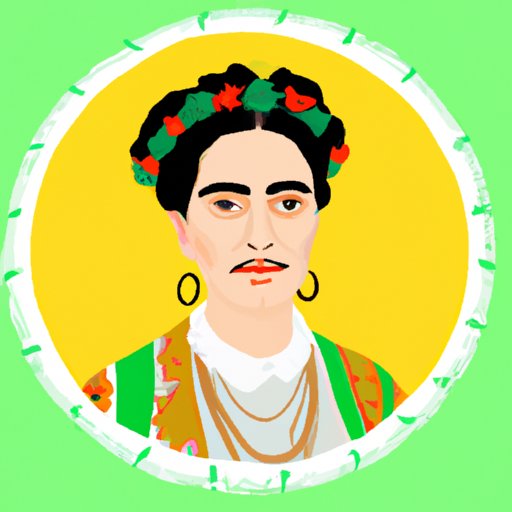Introduction
Frida Kahlo is a name that is known around the world. Her distinct artistic style and personal struggles have made her an icon of 20th-century art. Despite being born over a century ago, her legacy continues to inspire artists, activists, and ordinary people alike. In this article, we’ll explore what makes Frida Kahlo so famous and why her work remains relevant today.
The Artistic Brilliance and Tragic Life of Frida Kahlo: Why She Remains Relevant Today
Frida Kahlo’s art is characterized by its raw emotional power and vivid colors. Her paintings often depicted her own personal struggles, including her physical pain, difficult relationships, and the aftermath of a devastating accident she suffered as a teenager. She used her art to process her experiences and as a form of therapy.
Not only was her art deeply personal, but it was also groundbreaking in its style and technique. Kahlo’s work was heavily influenced by Mexican folk art and the Surrealist movement. She employed elements of both to create her own unique style that was a reflection of her own experiences and cultural identity. Her art was appreciated by other great artists at the time, including Pablo Picasso and André Breton.
Along with her art, Kahlo’s life story has also captivated people around the world. She struggled with poor health throughout her life, including fertility issues and chronic pain from her accident. She also had tumultuous relationships with both men and women, including her tumultuous marriage with fellow artist Diego Rivera. Despite all of this, she persevered and created a body of work that has stood the test of time.
Exploring the Iconic Works of Frida Kahlo: A Journey Through Her Artistic Legacy
Some of Frida Kahlo’s most famous works include “The Two Fridas,” “Self-Portrait with Thorn Necklace and Hummingbird,” and “The Broken Column.” Her paintings are rich with symbolism and often depict themes of pain, loss, and identity. She also used her art to make political statements about issues affecting Mexico at the time, such as indigenous rights and imperialism.
All of her paintings are characterized by a uniquely Mexican aesthetic that combines elements of European Surrealism, Mexican folk art, and her own personal style. Her paintings are instantly recognizable and continue to be appreciated for their emotional power and originality.
The Woman Behind the Paintings: Understanding the Life and Influences of Frida Kahlo
Like many great artists, Frida Kahlo’s personal life and cultural background played a significant role in shaping her art. She was born and raised in Mexico City and was deeply influenced by the political and social climate of her time. She was passionate about Mexican culture and often incorporated elements of it into her art.
Kahlo was also influenced by other artists, including her husband Diego Rivera, who was also a famous Mexican painter. She was also inspired by the European avant-garde movement, which she was exposed to during her travels in the United States and Europe.
From Controversy to Collectors: The Evolution of Frida Kahlo’s Art and Fame
During her lifetime, Frida Kahlo’s art was not always appreciated by the mainstream art world. She was often criticized for her raw and emotional style, which was seen as unrefined and crude. However, her work gained popularity during the feminist movement of the 1970s, which recognized her as a trailblazer for women artists.
Today, Frida Kahlo’s art is some of the most expensive in the world, with some of her paintings selling for tens of millions of dollars at auction. Her work is also appreciated by mainstream audiences and has been featured in numerous exhibitions and museums around the world.
Frida Kahlo Through the Ages: How Her Work Has Inspired Different Generations
One of the most remarkable things about Frida Kahlo’s legacy is how it has inspired artists and movements across generations. Her art has been used to represent everything from feminism to Mexican identity to political revolution.
Her influence can be seen in the work of contemporary artists like Kara Walker and Ana Mendieta, who have continued to push the boundaries of traditional representations of race, gender, and identity. Her impact on popular culture is also significant, with her image appearing on everything from t-shirts to coffee mugs to makeup.
Breaking Barriers: The Significance of Frida Kahlo’s Impact on Women in Art
Frida Kahlo was a trailblazer for women artists in a field dominated by men. She was one of the first female artists to be recognized for her work on a global scale and remains an inspiration for women in the art world today.
Kahlo’s art challenged traditional representations of women, portraying them as strong, complex individuals rather than passive objects. Her work is a testament to the power of art to challenge and subvert traditional gender roles and representations.
Frida Kahlo’s Political and Social Activism: How Her Art Reflects a Deeper Message
One of the most significant aspects of Frida Kahlo’s legacy is her activism and use of her art as a form of political commentary. Throughout her life, she was deeply involved in leftist politics and often used her work to make statements about issues affecting Mexico and the world at large.
Her paintings were often characterized by their political themes, from indigenous rights to communism to anti-imperialism. Her art was a reflection of her commitment to social justice and remains relevant today as a reminder that art can be a powerful tool for change.
Conclusion
Frida Kahlo’s art and life story have made her an icon of 20th-century art, with a legacy that continues to inspire and move people around the world. Her singular artistic style and deeply personal themes have made her work recognizable and appreciated by art lovers and laypeople alike. But more than that, her activism and commitment to social justice serve as a reminder that art can have a profound impact on the world we live in.
